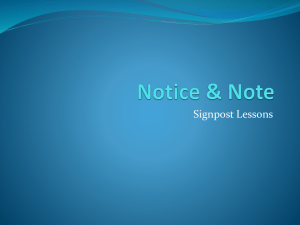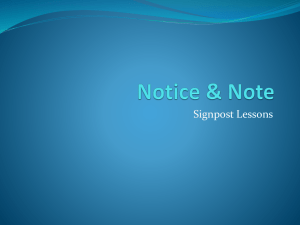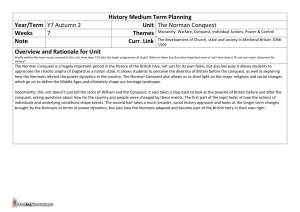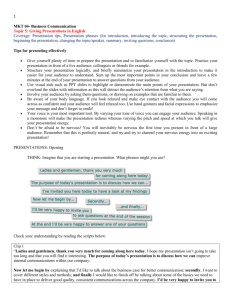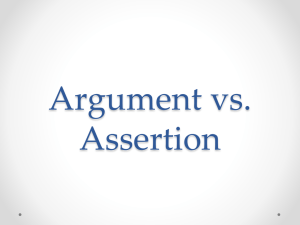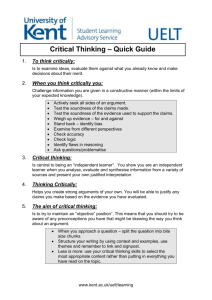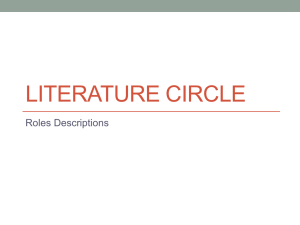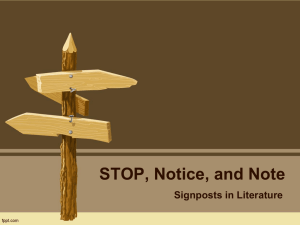Progression in Historical Thinking
advertisement
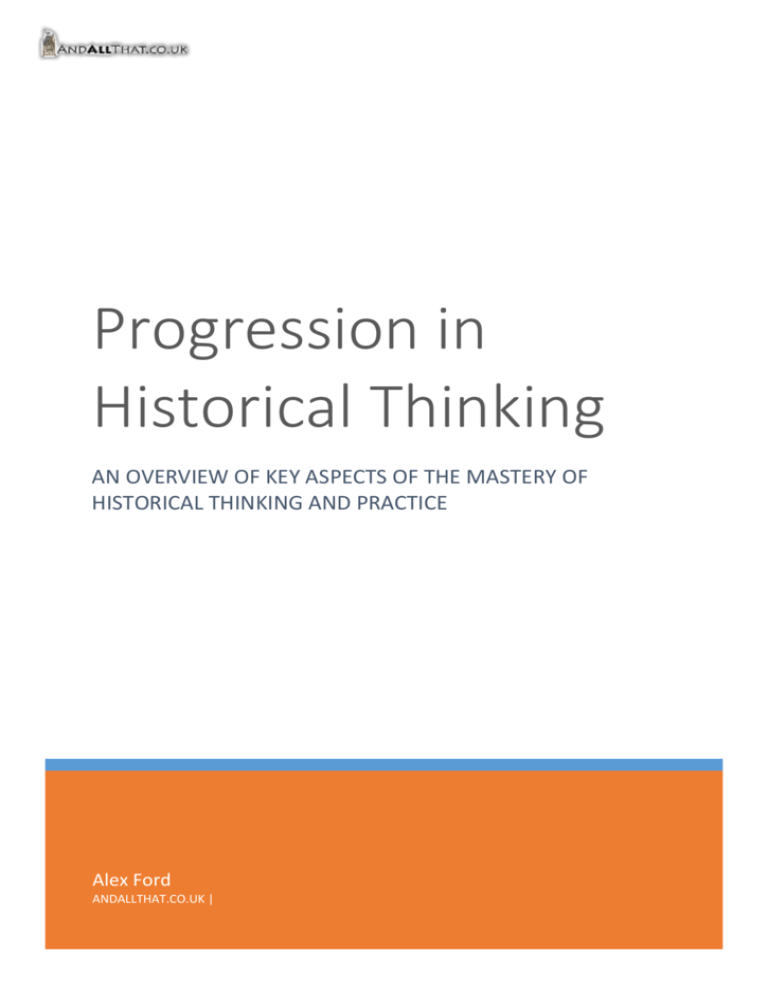
Progression in Historical Thinking AN OVERVIEW OF KEY ASPECTS OF THE MASTERY OF HISTORICAL THINKING AND PRACTICE Alex Ford ANDALLTHAT.CO.UK | Introduction As of September 2014, teachers are no longer required to use National Curriculum Levels to report on students’ attainment at Key Stage 3. Whilst this is very liberating in many ways, it does raise the thorny issue of how progress and attainment might be measured meaningfully in a post-Levels world. This pack endeavours to provide a meaningful set of guiding principles, and practical resources for assessing students’ historical understanding at Key Stage 3. Making Progress One core tenet of progression is that students should be engaged in a process of historical enquiry throughout their study of history (Byrom, 2013; Riley, 2000). Meaningful enquiries allow students to deepen their knowledge and understanding of key historical periods, issues and questions. The units in the Making Sense of History series are all based around enquiry questions. As part of such enquiries, students will be required to deepen their understanding, using second order historical concepts (for example causation, change and continuity, significance) to ask or explore meaningful questions. In answering these, students will also be expected to marshal a range of evidence drawn from primary or secondary materials. In order for this to be effective, students need to develop both in terms of the processes of historical enquiry, but also in mastering their use of the second-order concepts which underpin such enquiries. To assist teachers in developing students’ understanding of the thought patterns involved in enquiry, the model given below sets out common misconceptions students hold relating to different second-order concepts, as well as descriptions for what mastery of the particular concept looks like. The model is designed to support teachers in helping students to overcome their misconceptions about particular ways of thinking by providing meaningful feedback to students. All of the assessments in this pack are tied to these criteria. In this way, students and teachers will be able to understand and plan for progression in History. The second order concepts in the model are not designed however to be stand-alone marking criteria – they are inherently tied to the specific knowledge developed by students in each unit. Therefore, students are never being asked to demonstrate progress against artificial criteria, but instead are asked to apply second order concepts to specific historical contexts in order to develop meaningful answers. Indeed, the progression map given is not intended to be translated into ‘student-speak’ and atomised into level; it is designed to be applied where relevant and to inform teacher practice and feedback. The progression map will also help teachers when making judgements about how well students are progressing over time. It should also be noted that these assessments represent points at which teachers might engage in more formal checking of students’ understanding; however, they do not in themselves provide proof of progress. They should be seen as measures of attainment in specific assessments, at specific points in time – a theme dealt with later in this pack. Teachers should also therefore be aware that students need to develop their understanding of topics beyond just the specific objectives given here. Excellent history teaching means developing a breadth and depth of understanding rather than simply ticking off statements in a progression model. This pack is set up to encourage teachers to go beyond just the criteria; however teachers should always be looking for opportunities to develop their students holistically. Assessments Each assessment should have a specific mark scheme, against which teachers can mark students’ responses to the enquiry. Mark schemes should aim to take aspects of the second order concepts, as well as making direct reference to the specific knowledge (key people, dates and details, but also concepts such as monarchy, peasantry etc.) students might reasonably be expected to refer to in their answers. The assessments can be used 1 to provide students with an attainment grade which might be recorded for monitoring. As stated above, it is important to recognise that these assessments are reflections of student attainment at a specific point; they do not on their own give an indication of the progress a student has made. Equally, the progression map should not be seen as a series of statements to tick off in assessments, but as the base material around which meaningful historical enquiries and engaging history teaching might be woven. Outcomes One of the most important aspects of assessment in History is that students understand how they are doing in the subject, and how they can improve their understanding. This is not the same as encouraging students to memorise a series of criteria which define understanding. For too long, this has meant asking students to refer to their National Curriculum Level, and on setting generic targets connected to these. Any solution should be one which: allows students to understand how well they did on a specific assessment through the provision of a graded result eg. ‘very low’ to ‘very high’. This is of course adaptable to school circumstances gives teachers a vocabulary to discuss how students might improve their work without referring to generic targets or descriptors gives students some concept of their progress as historians over time. separates notions of progress and attainment so they do not become conflated and are clearer for students to understand. is flexible enough to be adapted to whole school assessment systems, or to be a model for such systems. 2 The Issue of Assessment in the 2014 Curriculum The change in emphasis from National Curriculum Levels means a significant challenge for schools seeking to create meaningful systems of assessment. It is therefore important to give some serious consideration to what assessment and reporting systems in schools could and should measure. The following is an attempt to clarify some of the key terms in assessment, and to try and draw some clear distinctions between three terms which have become somewhat conflated. Attainment Attainment might best be described as a measure of understanding at a particular point or in a particular assessment (for example an end of unit test, an end of lesson assessment, an end of year exam etc.). Attainment is effectively a summative mark (i.e. a grade A*–E, Fail, Pass, Merit, Distinction etc.). National Curriculum Levels were always intended as generic, best fit, end of Key Stage measures of attainment; they were not intended to be progression ladders up which students climbed. One of the big issues with the old National Curriculum Levels was that they were being used to measure and mark individual pieces of work, a task for which they were too vague and not well-suited. This resulted in a good deal of teacher interpretation being applied in using the levels, or in the worst cases, the stripping of meaningful subject knowledge from assessment and students being tested on generic subject ‘skills’. Progress Progress might be defined as a description of a student’s understanding over time. Progress might be best seen as an holistic measure which describes how a child's abilities, knowledge, understanding develop over a period. In History, this can be best seen through students’ ability to engage in historical enquiry over time. This means understanding students’ ability to ask, refine and explore meaningful questions; their grasp of second order concepts; their understanding of key knowledge; and their ability to marshal various forms of evidence. Progress cannot be pinpointed with a grade from a single piece of work; it must be described as a process. That is to say, is the progress slow, good, rapid etc.? One big issue with the old KS3 Levels was that progress came to be defined as movement between two data points, regardless of the fact that such points were targeting different topics, concepts, or skills. This was an erroneous use of KS3 Levels to describe progress, a task for which they were never designed. The following example hopefully illustrates the issue. In History, Jane Smith studies the reasons why William won the Battle of Hastings in term 1, the significance of the Reformation in term 2, and interpretations of the Civil War in term 3. Each term she is assessed and achieves a NC Level 5. By conventional logic, she has made no progress as she has not climbed the Levels ladder. This is clearly absurd – firstly, there is no parity between what she was assessed on conceptually, and secondly, she has understood each of these topics well and has deepened her historical understanding. Jane has made progress here, but the NC Level suggests she has made no progress. The only way such a claim would be true would be if Jane had been assessed on all three units from the beginning – then we would expect her to develop as she learned more content. Evidently it is impossible to assess students by testing them on the whole Key Stage at every assessment point, therefore any kind of system which tries to conflate attainment and progress is doomed from the start. Progression Model The progression model is the system which underpins how teachers enable and inform students to get better at a subject. The old National Curriculum Levels provided very poor progression models for most subjects, notably because they tried to subdivide subject progress into neat sections (attainment targets) and then split these into arbitrary rungs to climb. The rungs themselves seldom made logical sense in the context of the subject, which 3 meant that they became an impotent tool for assessing, planning and teaching. Equally, National Curriculum Levels, in aiming to be generic, took subject knowledge away from the second order concepts, meaning that students were being asked, in the worst cases, to make progress from one generic descriptor to another, with no reference to the historical period being studied. One classic example would be the advice given to students trying to move from a History Level 5 to 6, who might be told: ‘Analyse links between your factors’ or ‘Try to evaluate your evidence.’ Such statements were fairly meaningless outside the context in which they were studied. The progression model provided in this pack aims to move away from this linear way of thinking about progression and uses an approach of non-linear conceptual mastery. 4 A Suggested Model for Assessment The assessment model suggested here follows a tripartite approach and is based on the work done by Michael Fordham in the Historical Association Supplement for the 2014 Curriculum reforms (Fordham, 2013). The aim is to have a rigorous system of assessment which serves to inform teachers about how their students are progressing, whilst at the same time allowing for meaningful feedback to be given to students or parents. 1. Health Checks Health Checks are regular assessments of students’ knowledge. This includes their recall of key people, places, dates and events; their understanding of the chronology of the topic; and their understanding of abstract or complex terms such as ‘Divine Right’ or ‘peasantry’. Health Checks in this pack take the form of short, quiz-like task which might be used every one to two weeks to identify those students who are getting ‘chronologically lost’ (Fordham, 2013). Health Checks might also form part of informal reporting arrangements, and can help to reinforce teacher holistic judgements of students' understanding of the topics. 2. Formative Feedback Formative feedback should form an ongoing discussion between teachers and students in lessons, on work, and as part of tasks. Formative feedback will be linked to the misconceptions identified in the progression model, as well as the knowledge students’ are expected to develop in each unit. Comments should help students to overcome the kinds of misconceptions discussed in the progression model. The comments should be specific to the work being tackled, rather than referring to the concepts generically. For example, in a piece on why William won the Battle of Hastings, teachers may be encouraging students for links between factors. In this instance, the teacher might want the student to connect the knowledge that William had prepared and drilled his troops and that Harold’s army was exhausted. In this instance, a comment which says ‘You need to explain the link’ is less useful to a student that a specific comment such as ‘Why do you think Harold’s men fared less well that William’s once they actually met in battle? Is there a link here?’ It is suggested that time is given for students to respond to these comments, and correct or improve work, thereby allowing them to embed their new understanding. Teaching should also respond to misconceptions so the progression model may help in teachers targeting specific misconceptions as part of lessons or lesson sequences. Formative feedback should form the bulk of evidence of students making progress in their historical understanding. This has the added benefit of enabling teachers to have meaningful discussions about what students need to do related to specific topics, and how parents might support this. Once again, students should not be given copies of the progression map as a way of mechanistically marking off their understanding. Each concept is relevant to the specific knowledge being covered and must be applied in slightly different ways each time. Formal Assessments Formal assessments are points at which students’ attainment is measured and should be understood as providing a summative mark on a particular task against specific criteria. They draw together students’ understanding of substantive knowledge, their command of second order concepts, and their ability to engage in the process of historical enquiry. They should be marked against the specific mark schemes. It should be made clear that the grade students receive is for the specific task rather than representing a measure of their overall progress. Students should understand that they may produce a high level answer in one assessment, and a moderate level answer in the next, and still be making progress overall. 5 Students should also be given formative feedback on relevant parts of their assessments in the same vein as the guidance above. It is suggested that students are given time to refine their work based on the comments. Between these three aspects, it should be possible for teachers to construct a fairly comprehensive picture of students’ abilities, conceptual understanding and their historical knowledge. This should in turn allow teachers to build a sound picture of whether or not students are progressing in the subject overall sense. The issue of reporting The issue of reporting will be heavily tied to individual school decisions. However students might receive the following as part of the reporting process: 1. Formative feedback for larger and smaller assessments, upon which they have acted. 2. Measures of attainment: a. The results from ‘Health Checks’ – to be given to students at regular intervals for recording. b. Their assessment marks – students could receive a summative mark on particular unit assessments, building up a picture over the year. 3. Measures of progress: a. A qualitative judgement over time based on work students have completed. Ideally this would be no more than three times a year. b. Progress should be reported in a descriptive way to match its function as a measure over time. For example, student progress might be described as ‘None’, ‘Slow’, ‘Good’ or ‘Rapid’. Such descriptions are similar to the measures and descriptors used by Ofsted inspectors in lesson observations (a model for describing progress is given later). 6 A Progression Model for History The model which has been developed here is based on seven key aspects: six dispositions of historical thought referred to in the second order concepts (causation, change and continuity, using evidence, interpretations, significance and perspectives); and the process involved in historical enquiry. The progression model should be used to inform teaching and assessment; however it is not designed to be a standalone set of targets. Nor is it designed to provide a series of ladder like steps for students to climb. The concepts outlined here will need to be revisited by students throughout their historical studies, strengthening and building upon dispositions of thought in parallel with each other. The model is grounded in a theory of conceptual mastery, a slow process in which students are encouraged to undertake disciplined enquiry into the past in order to improve. For each key concept, and in line with the work of Morton and Seixas, (Morton & Seixas, 2012) a number of key ‘signposts’ have been identified. These are effectively the misconceptions which students need to overcome in order to work towards mastering the concept in question. There is no necessity for students to tackle each ‘signpost’ in turn, and indeed students may achieve more difficult aspects of the concept whilst still failing at the basics. The conceptual models are outlined below with some brief notes and explanation. The final point to reiterate is that these concepts do not exist in isolation – they are only relevant as part of the study of the historical periods. That is to say, a causation piece on the Norman Conquest is similar to one on the Reformation, but also has key differences rooted in the content. It is therefore crucial to understand that the progression model cannot be divorced from the specific historical content. Nor should it be divided into linear steps to show ‘progress’. It is expected that teachers develop and deepen students’ knowledge of each of the topics in the book through the use of meaningful enquiries, supported by second order concepts and relevant historical evidence. On historical knowledge It is worth outlining here the nature of current thinking on the importance of historical knowledge. Much of this is based on Kate Hammond’s excellent research in this area (Hammond, 2014). Clearly, students’ understanding of historical events, changes, people and periods is dependent on their ability to marshal large amounts of historical knowledge. However, there has been something of a false dichotomy drawn between historical knowledge and historical concepts (Counsell, 2000b). For students to deepen their understanding of history there needs to be interplay of historical knowledge and conceptual understanding. As stated previously, this can be tied together through the processes of valid historical enquiry. However, there are different qualities to students’ grasp of historical knowledge, which help to make distinctions between those students whose grasp of knowledge is fairly shallow, and those for whom the understanding goes deeper. The points outlined here are certainly worth bearing in mind when reaching a judgement about students’ progress in their understanding of history. If good knowledge is key to good history, then how such knowledge should be defined? 1. Students with good knowledge are able to work with different forms of knowledge. That is to say, students can make use of topic knowledge, relevant to the work they have been doing; however they are also able to display a wider knowledge of the period, and at the very top, are able to make reference to broader historical knowledge and understanding. For example, when explaining the causes of the Nazi rise to power 1929–33, a good student may refer to events which occurred in the early 1920s to bring in period knowledge, but could equally refer to the behaviour of voters in times of economic crisis more broadly to bring in their wider historical understanding. 7 2. Students with good knowledge are able to work with multiple pieces of historical knowledge in parallel, bringing these to bear on statements or claims made about the past. Hammond refers to this process as the student’s underlying historical understanding ‘flavouring’ what they write. To take the Nazi rise to power example again, a good student may refer to the behaviour of voters in Germany belying a deeper understanding that they were not a single homogenous mass, whereas a weaker student may deal with ‘The Public’ as a seemingly single entity. History teachers sometime need to look hard for where this historical ‘flavouring’ is influencing their students’ work. 3. Finally, students with good knowledge are able to switch between historical frames when appropriate. For example, a student with good knowledge discussing the rise of the Nazis may zoom out to explore the wider significance of the economic crises of 1923 and 1929 on Germany, before returning to explain the relevance of the Great Depression. A weaker student may not see the necessity of providing this context, or may provide context when not strictly necessary. As such there are three key things to say about historical knowledge: 1. Historical knowledge really matters as it shows that students understand a period, and that understanding should increasingly include the broader historical context. As such, historical knowledge should be a core part of all historical enquiries and explanations, not something simply bolted on afterwards. 2. Students should aim to bring in historical knowledge on a range of time frames and in a variety of ways. 3. Teachers need to be aware of the subtlety of historical knowledge. This leaves a number of key challenges for history teachers to enable students to retain their knowledge in the long term, so that it can carry on flavouring their answers. It also raises the challenge that teachers cannot accept the ‘anything goes’ mentality that a supporting piece of evidence always validates a claim. There is a real need for teachers to encourage the development of accurate and appropriate historical knowledge. 8 1) Causation SIGNPOST 1 Causal Webs 4) Historical Interpretations SIGNPOST 2 Influence of Factors Change happens because of MULTIPLE CAUSES and leads to many different results or consequences. These create a WEB of related causes and consequences. Different causes have different LEVELS OF INFLUENCE. Some causes are more important than other causes. SIGNPOST 3 Personal and Contextual Factors Historical changes happen because of two main factors: The actions of HISTORICAL ACTORS and the CONDITIONS (social, economic etc.) which have influenced those actors. SIGNPOST 4 Unintended Consequences HISTORICAL ACTORS cannot always predict the effects of their own actions leading to UNINTENDED CONSEQUENCES. These unintended consequences can also lead to changes SIGNPOST 1 Identifying Interpretations SIGNPOST 2 Drawing Inferences from Interpretations SIGNPOST 3 Evaluating Interpretations SIGNPOST 4 Interpretations in Context Historical interpretations are everywhere. Every piece of historical writing is an interpretation of some sort. The past is not fixed but CONSTRUCTED through interpretations. It is possible to draw INFERENCES from interpretations of the past, just like with historical sources. INFERENCES will reveal the MESSAGE of a particular interpretation. The APPROACH of an author must always be considered. This means considering their VIEWPOINT, PURPOSE, AUDIENCE and EVIDENCE chosen to build their interpretation and how this might impact on the final interpretation. Historical interpretations must be understood on their own terms. This means thinking about the CONTEXT in which they were created, what conditions and views existed at the time, and how this might impact the final interpretation. 2) Change & Continuity 5) Significance SIGNPOST 1 Identifying Change SIGNPOST 1 Resulting in Change Events, people and developments are seen as significant because the RESULTED IN CHANGE. They had consequences for people at and/or over time. SIGNPOST 2 Revelation Significance is ascribed if they REVEAL something about history or contemporary life. SIGNPOST 3 Identifying Significance Criteria Significance is seen as something constructed therefore CRITERIA are needed to judge the significance of events, people or developments within a particular historical narrative. Historical significance varies over time, and by the INTERPRETATIONS of those ascribing that significance. Significance is PROVISIONAL. SIGNPOST 2 Interweaving Continuity and Change SIGNPOST 3 Flows of Continuity and Change SIGNPOST 4 Complexity of Change Past societies are not fixed, there are changes which have occurred spanning centuries. Changes in the past can be identified by looking at DEVELOPMENTS between two periods. Change and continuity are INTERWOVEN and both can be present together in history. CHRONOLOGIES can be used to show change and continuity working together over time. Change is a process which varies over time. Change can be described as a FLOW in terms of its PACE and EXTENT and can be said to TRENDS and have specific TURNING POINTS. Change and continuity are not a single process. There are many FLOWS of change and continuity operating at the same time. Not all FLOWS go in the same direction SIGNPOST 4 Provisional Significance 3) Historical Evidence 6) Historical Perspectives SIGNPOST 1 Inferences from Sources SIGNPOST 1 Appreciating world-views There are major differences between modern WORLDVIEWS and those of people in the past. Differences are seen in their beliefs, values and motivations. We must avoid PRESENTISM. SIGNPOST 2 Perspectives in context The perspectives of HISTORICAL ACTORS are best understood by thinking about the CONTEXT in which people lived and the WORLD-VIEWS that influenced them SIGNPOST 3 Perspectives through evidence SIGNPOST 4 Diversity Looking at the perspective of an HISTORICAL ACTOR means drawing INFERENCES about how people thought and felt in the past. It does not mean using modern WORLD-VIEWS to imagine the past A variety of HISTORICAL ACTORS have very different (DIVERSE) experiences of the events in which they are involved. Understanding DIVERSITY is key to understanding history. SIGNPOST 2 Cross Referencing Sources SIGNPOST 3 Source Utility SIGNPOST 4 Evaluating Sources SIGNPOST 5 Sources in Context When we write history we need to create interpretations of the past based on evidence. INFERENCES are drawn from a variety of primary sources to create interpretations of the past. Historical evidence must be CROSS-REFERENCED so that claims are not made based on single pieces of evidence. CROSS-REFERENCING means checking against other primary or secondary sources. Historical evidence has multiple uses. The UTILITY of a piece of historical evidence varies according to the specific enquiry or the questions being asked. Working with evidence begins before the source is read by thinking about how the AUTHOR, intended AUDIENCE and PURPOSE of an historical source might affect its WEIGHT for a purpose. Historical evidence must be understood on its own terms. This means thinking about the CONTEXT in which the source was created and what conditions and views existed at the time. 9 1. Causation MODEL BASED ON (SCOTT, 1990) AND (MORTON & SEIXAS, 2012) Understanding ‘causation’ in history is crucial for students to make sense of the past. At a basic level, causation appears to be the bread and butter of history. The causation model outlined here attempts to get student to understand a number of key strands: 1. Change happens because of MULTIPLE CAUSES and leads to many different results or consequences. These create a CAUSAL WEB. 2. RANKING CAUSES: Different causes have different LEVELS OF INFLUENCE. Some causes are more important than other causes. 3. UNDERLYING CAUSES: Historical changes happen because of two main factors: a. the actions of HISTORICAL ACTORS b. the CONDITIONS (social, economic etc.) which have influenced those actors. 4. HISTORICAL ACTORS cannot always predict the effects of their own actions leading to UNINTENDED CONSEQUENCES. These unintended consequences can also lead to changes. Signpost 1 Causal Webs Signpost 2 Ranking Causes Signpost 3 Underlying Causes Signpost 4 Unintended Consequences Misconceptions Mastery Causation is attributed to a single cause, usually short term, or multiple causes are given but not explained. There is no differentiation between the influence of various causes. Multiple short-term and long-term causes of events are identified and explained. Relationships between causes are recognised. The causes of historical change are analysed and different causes are ranked by their influence. Historical causes are personalised to be the actions of great leaders or are seen as abstractions with human intentions. Historical change is explained through the interplay of the actions of historical actors and the underlying conditions in which they operated (for example: social, political, economic, religious or military conditions). A differentiation is made between the intended and unintended consequences of actions. Past events are seen as the result of specific plans and actions. 2. Change and continuity MODEL BASED ON (BLOW, 2011), (MORTON & SEIXAS, 2012) AND (FOSTER, 2013) Understanding the processes of change and continuity enables students to appreciate the past, not as a homogenous whole, nor indeed as a series of events, but as a complex flow of currents and counter-currents. It helps students to appreciate the complexity of the past and creates uncertainty around loaded terms such as ‘primitive’ and ‘progress’. Again, there are four key strands to this concept: 1. Past societies are not fixed, there are changes which have occurred spanning centuries. Changes in the past can be identified by looking at DEVELOPMENTS between two periods. 2. Change and continuity are INTERWOVEN and both can be present together in history. CHRONOLOGIES can be used to show change and continuity working together over time. 3. Change is a process which varies over time. Change can be described as a FLOW in terms of its PACE and EXTENT and can be said to TRENDS and have specific TURNING POINTS. 10 4. Change and continuity are not a single process. There are many FLOWS of change and continuity operating at the same time. Not all FLOWS go in the same direction. Misconceptions Signpost 1 Identifying change Seeing the past as homogenous and unchanging. Failing to perceive that changes happen over time. Signpost 2 Interweaving change and continuity Failing to appreciate that change and continuity can happen simultaneously. Signpost 3 Process of change Seeing all changes as individual events with short term impacts. Signpost 4 Complexity of change Believing that change is a single process which ebbs and flows over time. Mastery Understanding that changes can be seen as differences between two periods of time, i.e. what has changed between two points in history, or conversely, what has stayed the same. Change and continuity are shown to be INTERWOVEN. Some things change whilst others remain stable. Understanding that historical change and can be described as a flow over a longer period of time in terms of pace, extent, trends or specific turning points and that these flows might have greater importance than the changes individually. Understanding that the past is formed of multiple lines of development and that each has its own flow but that these do not always go in the same direction as the larger river of history. 3. Historical Evidence MODEL BASED ON: (LEE & SHEMILT, 2003), (WINEBURG, 1999) AND (MORTON & SEIXAS, 2012) Without evidence, there is of course no history to speak of, only speculation. This was one of the trickiest aspects to create a model for as working with evidence is such a complex process. I have tried to take some of the complexity of Wineburg’s thinking on the issue whilst also looking at the practicalities of the classroom. When working with sources the danger is that we simply read them uncritically or through a modern lens. As Wineburg notes, the ‘spread of activation’ effect leads us to think down similar lines of thought once we have been pushed in a certain direction. For example, when looking at a document which discusses slavery, then the modern mindset overrides other aspects of the document and leads us to condemn the practice without engaging with the meaning of the source itself. Wineburg gives the example of a group of people given an 1892 document about Columbus Day. Nonhistorians used the document to comment on the shame of Columbus’ conquest in 1492; these readers used the source to ‘… confirm their prior beliefs. They encountered the past here and labelled it.’ (Wineburg, 1999, p. 498). Yet on the other hand, ‘…historians used the document to puzzle about 1892, not 1492. They paused long enough to allow their eyes to readjust from the flashing neon of Columbus’ name to go down to the bottom of the document to ponder the context of the document’s production.’ (Wineburg, 2007, p. 11) Historians contextualised the document about Columbus instead of using it as a window on the past. With this in mind, the strands for the evidence concept are quite complex: 1. When we write history we need to create interpretations of the past based on evidence. INFERENCES are drawn from a variety of primary sources to create interpretations of the past. 2. Historical evidence must be CROSS-REFERENCED so that claims are not made based on single pieces of evidence. CROSS-REFERENCING means checking against other primary or secondary sources. 11 3. Historical evidence has multiple uses. The UTILITY of a piece of historical evidence varies according to the specific enquiry or the questions being asked. 4. Working with evidence begins before the source is read by thinking about how the AUTHOR, intended AUDIENCE and PURPOSE of an historical source might affect its WEIGHT for a purpose. 5. Historical evidence must be understood on its own terms. This means thinking about the CONTEXT in which the source was created and what conditions and views existed at the time. Misconceptions Signpost 1 Drawing Inferences Seeing evidence as a series of windows on the past or a collection of facts to be unearthed. Signpost 2 Cross Referencing Claims about the past are often shaky or unwarranted as they are based on single pieces of evidence. Signpost 3 Utility of Evidence Seeing evidence as inherently useful or otherwise based only on what it says. Signpost 4 Evaluating Evidence The provenance of evidence is not questioned. Signpost 5 Evidence in Context Understanding historical evidence and inferences from evidence through a modern mindset. Judgements are made without reference to context. Mastery Understanding that the past is not a set of fixed and known events and that evidence isn’t a collection of facts about the past. Understanding that inferences can be drawn from evidence which go beyond the obvious content of the sources. Understanding that history is a complex web and should be constructed from a wide array of complimentary and contradictory sources. Commenting of the certainty of inferences drawn from multiple sources. Understanding that all evidence can have multiple uses and that its utility depends on the questions which are being asked. Evidence does not have a fixed value of utility; it varies according to the enquiry. Understanding that a source will reflect the views of its author. Explaining the impact of author, audience, and purpose on a source. Historical evidence should be understood on its own terms and be recognised as an area of complexity and confusion. Interpreting historical evidence in historical terms rather than understanding it through a modern mindset. Sources cannot be understood quickly and easily – they require work. Context has an enormous impact on the meaning of a source. 4. Historical Interpretations MODEL BASED ON (LEE & SHEMILT, 2004) Understanding historical interpretations means asking students to step back and appreciate the processes of the discipline of History itself. In many cases, this is a skill we do not expect of students until they are much older as the contextual knowledge required is so great. It is also important to note that historical interpretations here refer to conscious reflections on the past, deliberate attempts to make sense of past events, and should not be confused with sources or personal views. 1. Historical interpretations are everywhere. Every piece of historical writing is an interpretation of some sort. The past is not fixed but CONSTRUCTED through interpretations. 2. It is possible to draw INFERENCES from interpretations of the past, just like with historical sources. INFERENCES will reveal the MESSAGE of a particular interpretation. 3. The APPROACH of an author must always be considered. This means considering their VIEWPOINT, PURPOSE, AUDIENCE and EVIDENCE chosen to build their interpretation. 4. Historical interpretations must be understood on their own terms. This means thinking about the CONTEXT in which they were created and what conditions and views existed at the time. 12 Mastery Signpost 1 Identifying Interpretation Misconceptions The past is seen as knowable and therefore interpretations of the past are all just different ways of relating the same events. Signpost 2 Inferences from Interpretations Inferences are not drawn from interpretations. Information may be extracted from an interpretation. The messages and main points of an interpretation are identified. This is done through reference to the interpretation itself. Signpost 3 Evaluating Interpretations Accounts of the past are either used uncritically or are seen as accurate versions of the past containing mistakes – either deliberate (bias) or accidental. Signpost 4 Interpretations in Context Interpretations are seen as views on the past but are not understood in the context of their own time. Interpretations are understood to be particular viewpoints and constructions of the past. An interpretation is seen as the product of a particular author. The APPROACH of the author is identified and an understanding is shown of the viewpoint of the author, their purpose, their intended audience and the evidence they have chosen to use. Understanding that the context of an historical interpretation is often more important than the period it is talking about. Interpretations can reveal a lot about the context in which they were created and could be put to this purpose. 5. Significance MODEL BASED ON (COUNSELL, 2004), (PHILLIPS, 2002) AND (MORTON & SEIXAS, 2012) 1. Events, people and developments are seen as significant because they RESULTED IN CHANGE. They had consequences for people at and/or over time. 2. Significance is ascribed if they REVEAL something about history or contemporary life. 3. Significance is seen as something constructed therefore CRITERIA are needed to judge the significance of events, people or developments within a particular historical narrative. 4. Historical significance varies over time, and by the INTERPRETATIONS of those ascribing that significance. Significance is PROVISIONAL. Signpost 1 Resulting in Change Signpost 2 Revelation Signpost 3 Identifying Significance Criteria Signpost 4 Provisional Significance Misconceptions There is a reliance on a textbook or other authority to assign significance. Or relies on a personal preference as the basis for significance. Criteria for determining significance are limited to the impact of a person, event or development. Unable to identify the criteria used by textbooks or other historical accounts to establish the significance of events or people. Significance is seen as fixed and unchanging – i.e. it is inherent in an event, person or development. 13 Mastery The significance of events, people or developments are explained by showing how they resulted in change. Historical significance is explained by showing what people, events or developments reveal about issues in history or contemporary life. The criteria used to establish historical significance in textbooks and other historical accounts are identified and explained. Historical significance is shown to vary over time and from group to group. Some reasons for this are given. 6. Historical Perspectives MODEL BASED ON (WINEBURG, 1999; 2007) AND (MORTON & SEIXAS, 2012) One of the most crucial aspects of understanding history is trying to see the past on its own terms. Too often students place modern values on top of the past and therefore fail to understand why people acted in the way they did. When speaking to students about the Holocaust, Primo Levi once noted that he increasingly faced the question: why did you not escape or rebel? These students are viewing History through their own modern lens of understanding rather than trying to engage with the strange world of the past. As Richard White notes: ‘Any good history begins in strangeness…the past should not be a familiar echo of the present…’ (White, 1998, p. 13). History exposes our inability to understand people in the past on their own terms. In order to do it well we need to try and understand the mentalities of those in the past. History helps us to practice understanding peoples we cannot hope to understand – this is a crucial lesson today (Wineburg, 1999). 1. There are major differences between modern WORLD-VIEWS and those of people in the past, this means their beliefs, values and motivations. We must avoid PRESENTISM. 2. The perspectives of HISTORICAL ACTORS are best understood by thinking about the CONTEXT in which people lived and the WORLD-VIEWS that influenced them. 3. Looking at the perspective of an HISTORICAL ACTOR means drawing INFERENCES about how people thought and felt in the past. It does not mean using modern WORLD-VIEWS to imagine the past. 4. A variety of HISTORICAL ACTORS have very different (DIVERSE) experiences of the events in which they are involved. Understanding DIVERSITY is key to understanding history. Misconceptions Signpost 1 Appreciating Views World- Signpost 2 Perspectives in Context Signpost 3 Perspectives evidence Signpost 4 Diversity through There is an assumption that the beliefs, values and motivations of people in the past were the same as those of people today. Presentism abounds. A lack of historical empathy with people of the past. An assumption that people in the past were stupid or ignorant because their historical context is ignored. Empathising with Historical Actors is often conducted as an imaginative exercise with little or no reference to evidence or historical context. A failure to recognize that there are a diverse range of perspectives in the past. 14 Mastery An understanding of the differences between the world-views of people in the past and the present day. Understanding that caution is needed when trying to understand Historical Actors through shared human experiences eg. Death, fear, love or hunger. Understanding that the perspectives of people in the past have to be explained with reference to their historical context. A respect for the lives of people in the past. Evidence based inferences are used to empathise with an Historical Actor. Evidence is used to reconstruct beliefs, values and motivations. Limitations of our understanding are recognised. The ability to distinguish a variety of diverse perspectives and experiences in the past. Evidence is used to reconstruct these different perspectives with respect. Core Process: Historical Enquiry MODEL BASED ON HAMMOND (HAMMOND, 2011) & DAWSON (DAWSON, 2014) 1. There is a recognition that an historical enquiry involves ASKING QUESTIONS about the past. Historical ENQUIRIES are rooted in SECOND ORDER concepts and can be pursued INDEPENDENTLY. 2. There are a range of POSSIBLE ANSWERS to historical questions, however some of these may be less VALID than others. 3. Historical claims need to be refined by seeking EVIDENCE and asking FURTHER QUESTIONS. 4. Claims made in historical enquiries need to be SUPPORTED by EVIDENCE. 5. Historical claims need to be communicated with CLARITY and PRECISION. Different historical claims have a greater degree of CERTAINTY than others. Misconceptions SIGNPOST 1 Asking questions SIGNPOST 2 Suggesting answers Enquiry is not really understood. History is seen as a collection of facts which do not need further interrogation. Answers to questions are suggested with little consideration for the historical period or the validity of such answers. All answers are seen as equally valid OR only one answer is seen as valid. Little independence is shown in suggesting answers. SIGNPOST 3 Refining claims SIGNPOST 4 Supporting with evidence Claims are not refined and there is little or no recognition of the process involved in making historical claims. Limited independence is shown. Claims arising from enquiries are based on conjecture or limited evidence. Evidence might be taken at face value, or evidence of a contradictory nature may be ignored or misunderstood. Claims arising from enquiries are SUPPORTED by a range of relevant evidence. Evidence is used critically and in context to build and support complex claims about the past. Evidence informs processes of questioning and refinement. INDEPENDENCE is shown in sourcing and referencing evidence. Claims arising from historical questions are communicated in a simplistic manner with little or no reference to how certain such claims are. Claims arising from historical questions are communicated with CLARITY and PRECISION. There is a recognition of the degree of CERTAINTY of a particular claim as well as of other POSSIBILITIES. Enquiries show considerable levels of INDEPENDENT thinking. SIGNPOST 5 Communicating with degrees of Mastery Enquiry is tackled as a process of ASKING QUESTIONS. Questions asked will enable lines of enquiry to be pursued. Students develop an ability to ask RELEVANT questions INDEPENDENTLY. Students use a grasp of SECOND ORDER concepts to help frame appropriate questions Recognition that questions may have a MULTITUDE of answers and that some answers may have more VALIDITY than others. Recognising a range of POSSIBILITIES. Answers are suggested showing INDEPENDENT thought. Claims arising from historical questions are REFINED by asking further questions after the gathering of evidence. Questions help to develop and deepen the understanding of an enquiry and answers become more plausible. INDEPENDENT thinking is shown in the process of refining claims. certainty 15 Making Judgements about Progress Many schools will ask teachers to make judgements about students’ progress in their subject. The model set out here takes the view that assessments of progress should: be based on teacher assessment in conjunction with other assessment evidence be descriptive rather than trying to assign a particular mark or grade not attempt to define progress in terms of assessment results alone be straightforward to implement. be grounded in real classroom observation. As such, the descriptors below set out a four-stage model for describing students’ progress in History. Each stage is represented by characteristic steps. Teachers would need to apply this on a best-fit basis, taking into account evidence of student performance in terms of: assessments performance in class written and verbal performance engagement ability to develop understanding conceptual awareness ability to work with historical enquiries development of specific knowledge. PROGRESS DESCRIPTOR Little or none Slow Good INDICITIVE EVIDENCE Students are a cause for concern because they: fail to grasp new ideas and concepts introduced in lessons do not deploy new ideas or concepts in their written, or other work fail to communicate their ideas effectively do not respond to feedback in a meaningful way, or ignore feedback altogether. repeatedly make the same mistakes, and do not move beyond misconceptions they have developed about the subject, despite being given feedback and assistance show little or no understanding in assessments. Students need further support because they: grasp new ideas and concepts more slowly than their peers, and seem less confident in their understanding struggle to deploy new ideas and concepts in their work, or may need prompting in order to do so effectively struggle with some aspects of communicating their ideas effectively respond to feedback to some extent, but do not always address the issues being identified overcome some of their misconceptions about the subject but continue to make similar mistakes. This improves with support show some understanding in assessments, although this may vary over time. Students are making good progress because they: grasp new ideas and concepts in line with their peers for the most part, although they may not always be fully confident in their understanding deploy new ideas and concepts in their work with limited prompting have an awareness of the links between ideas and concepts previously studied and newer ones being introduced communicate their ideas effectively most of the time 16 Rapid respond to feedback in the majority of tasks, modifying and refining their ideas and work with reasonable effectiveness work on overcoming misconceptions about the subject, meaning that repeated mistakes about ideas or concepts are uncommon Show sound understanding in assessments, with some variation over time. Students are making rapid progress because they: grasp the vast majority of new ideas and concepts quickly and confidently show good awareness of the links between ideas and concepts previously studied and newer ones being introduced communicate their ideas effectively for the vast majority of the time respond well to feedback and refine ideas and work effectively work to overcome misconceptions about the subject, seldom continuing to make the same mistakes in work show good understanding in assessments with little variation over time. 17 Bibliography Blow, 2011. Everything Flows And Nothing Stays. Teaching History, Issue 145, pp. 47-55. Byrom, J., 2013. Alive … and Kicking? Some personal reflections on the revised National Curriculum (2014) and what we might do with it. The Historical Association Curriculum Supplement, pp. 6-14. Counsell, C., 2000b. Historical Knowledge and Historical Skills: A distracting dichotomy. In: J. Arthur & R. Philips, eds. Issues in Teaching History. London: Routledge. Counsell, C., 2004. Looking Through a Josephine Butler Shaped Window. Teaching History, Issue 114, pp. 30-34. Dawson, I., 2014. Thinking History. [Online] Available at: http://www.thinkinghistory.co.uk/EnquirySkill/Index.html [Accessed 22 06 2014]. Fordham, M., 2013. O brave new world, without those levels in't: where now for Key Stage 3 assessment in history?. The Historical Association Curriculum Supplement, pp. 15-23. Foster, R., 2013. The More Things Change, The More They Stay The Same. Teaching History, Issue 151, pp. 8-16. Hammond, K., 2011. Pupil led historical enquiry: what might this actually be?. Teaching History, Issue 144, pp. 4450. Hammond, K., 2014. Wrestling with Knowledge. London, The Historical Association. Lee, P. & Shemilt, D., 2003. A scaffold not a cage: progression and progression models in history.. Teaching History, Issue 113, pp. 13-23. Lee, P. & Shemilt, D., 2004. Progression in Understanding About Historical Accounts. Teaching History, Issue 117, pp. 25-31. Morton, T. & Seixas, P., 2012. The Big Six Historical Thinking Concepts. Toronto: Nelson Education. Phillips, R., 2002. Historical Significnace: The forgotten key element. Teaching History, Issue 106, pp. 14-19. Riley, M., 2000. Choosing and planting your enquiry questions. Teaching History, Issue 99, pp. 8-13. Scott, J., 1990. Understanding Cause and Effect. London: Longman. White, R., 1998. Remembering Ahanagran: story telling in a family's past. New York: Hill & Wang. Wineburg, S., 1999. Historical thinking and other unnatural acts. Phi Delta Kappan, 80(7), pp. 488-499. Wineburg, S., 2007. Unnatural and essential: the nature of historical thinking. Teaching History, Issue 129, pp. 611. 18
